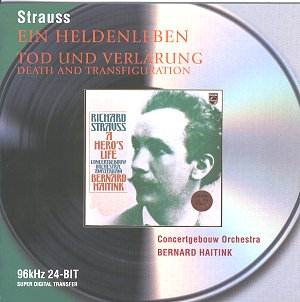 Composer: Richard Strauss (1864-1949)
Composer: Richard Strauss (1864-1949)
Works: Heimliche Aufforderung Op. 27, No. 3 in B flat (1895), Allerseelen Op. 10, No. 8 in E flat (1885), Ständchen Op. 17, No. 2 in F (1885-7), Ruhe meine Seele Op. 27, No. 1 in C (1895), Morgen Op. 27, No. 4 in G (1895), Zueignung Op. 10, No. 1 in C (1885), Traum durch die Dammerung Op. 29, No. 1 in F sharp (1895), Ich trage meine Minne Op. 32 No. 1 in G flat (1896), Liebeshymnus Op. 32 No. 3 in B (1896), Verfuhrung Op. 33 No. 1 in E (1896), Das Rosenband Op. 36 No. 1 in A (1897-8), Befreit Op. 39, No. 4 in E minor (1898), Wiegenlied Op. 41, No. 1 in D (1899), Freundliche Vision Op. 48, No. 1 in D (1900), Waldseligkeit Op. 49, No. 1 in F sharp (1900-1), Die heiligen drei Konige aus Morganland Op. 56, No. 6 in C (1903-6), Capriccio Conversation piece for Music Op. 85 (1942), Der Rosenkavalier: Second waltz suite Op. 59 (1911)
Performers: Steve Davislim (tenor), State Orchestra of Victoria/Simone Young
Recording: August 1999, Iwaki Auditorium, Melbourne, Australia
Label: Melba 301081
Richard Strauss stands as one of the titans of late Romantic music, whose lieder represent a paragon of vocal and orchestral integration. This latest release, featuring the tenor Steve Davislim and the State Orchestra of Victoria under Simone Young, encapsulates the essence of Strauss’s art through a carefully curated selection of songs. The program spans nearly three decades of Strauss’s prolific output, showcasing his evolution from the early, lyrical innocence of his youth to the more complex emotional landscape of his later years. Each work encapsulates a world of poetic sentiment and orchestral color, reflecting the composer’s intimate connection to his wife and muse, Pauline de Ahna.
Davislim’s interpretive choices reveal a profound understanding of Strauss’s nuanced musical language. His performance of “Heimliche Aufforderung,” a delicate and intimate piece, is particularly compelling. Here, he captures the fervent anticipation of lovers, highlighting the song’s inherent tension with a beautifully controlled legato and subtle dynamic shading. The orchestration, enriched by Young’s adept conducting, adds depth without overshadowing the vocal line. In “Allerseelen,” Davislim navigates the poignant nostalgia with a tenderness that evokes the bittersweet nature of remembrance. The orchestral accompaniment, with its lush strings and gentle woodwind flourishes, enhances the sense of longing while showcasing Strauss’s masterful blend of lyricism and orchestral color.
Technical prowess is a hallmark of this recording. Davislim’s breath control and range are commendable, particularly in the soaring lines of “Morgen,” where he conveys an ethereal quality that is both enchanting and transcendent. The engineering of the recording captures the warmth of Davislim’s voice, allowing it to resonate beautifully against the rich tapestry of the orchestra. The clarity of the sound design ensures that each instrumental detail is discernible, from the shimmering harp in “Morgen” to the gentle orchestral swells in “Zueignung.” This attention to acoustics enhances the listening experience, allowing the audience to appreciate the intricate interplay between voice and orchestra.
Simone Young’s leadership of the State Orchestra of Victoria merits particular praise. Her ability to evoke the subtleties of Strauss’s orchestration is evident across the breadth of the program. In “Ruhe meine Seele,” the orchestral texture, reminiscent of Wagner’s harmonic language, is rendered with a clarity that supports the vocal line effectively. Young’s nuanced conducting ensures that moments of stillness are as impactful as the climactic passages, allowing the listener to fully engage with the emotional arcs of each song. The orchestral interludes, such as those in “Verfuhrung,” are treated with a symphonic grandeur that reflects Strauss’s operatic inclinations, yet Young maintains a delicate balance that respects the song cycle’s intimate nature.
This recording stands as a significant addition to the discography of Strauss’s lieder. The selection is not only representative of his artistic development but also serves to highlight the unique qualities of each piece. Comparatively, while there are numerous notable recordings of Strauss’s songs, Davislim’s interpretation, coupled with Young’s orchestral direction, offers a freshness that is both engaging and illuminating. This album is a testament to the enduring power of Strauss’s music, showcasing the delicate interplay of love, longing, and the sublime beauty of the human voice.
The meticulous attention to detail in both performance and production results in a recording that is both artistically profound and sonically satisfying. It is a compelling showcase of Richard Strauss’s lieder, brought to life through the vocal artistry of Steve Davislim and the vibrant orchestral support of the State Orchestra of Victoria. This release not only honors Strauss’s legacy but also reinforces the continuing relevance of his music in today’s concert repertoire.



